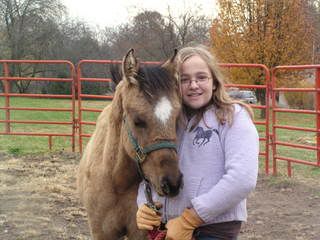Post by Michelle Clarke on Dec 16, 2007 8:16:23 GMT -5
Odd Things that Horses Eat
Sarah L. Ralston, VMD, Ph.D., dACVN, Department of Animal Science, Cook
College, Rutgers University
Fact Sheet #062 - Reviewed 2004
Horses are adapted to a diet based primarily of forages. Their digestive systems are geared toward the digestion of high roughage feeds that change slowly (for example, sudden access to a bag of grain or lush pasture after they have eaten only dry hay for the previous 5 months is likely to result in colic). However, with domestication, confinement, and modern technology, we are often confronted with horses that consume some really “odd” things with apparent relish. Feeding practices around the world differ and horses in other countries are commonly fed things that average American horse owners would never consider offering to their horses. For example, European horses are routinely fed silage, horses in Saudi Arabia munch happily on dried fava beans, and Irish horses are offered a weekly pint of ale or stout! With the above digestive constraints and variation in mind, what is presented here is by no means an exhaustive list of non-traditional things that might be consumed by horses. It is a list of things that horses have been reported to eat by veterinarians and horse owners around the world. Those that might adversely affect the horse’s health, and therefore be avoided or at least limited, are so identified.
Oddities often consumed by horses on pasture
No problem, assuming fairly limited quantities and otherwise balanced ration:
Dandelion
Thistle (NOT Russian Knapweed or yellow star thistle–Centaurea spp)
Sunflower seeds and plant
Peanut plants
Raspberry/blackberry bushes
Wood/bark of most trees (NOT Prunus spp or black walnut or locust)
Potential problem if eaten in large quantities
Buttercup
Morning glory
Pokeweed
St. Johnswort
Gum-weed
Astragulus and Oxytropis spp/(vetches and locoweed)
Avocado leaves
Bracken fern
Most bulb type flowers (tulip, iris, etc.)
Wilted red maple leaves
Acorns/new oak leaves
Avoid at all costs (Lethal or severe toxicity potential)
Lily of the Valley
Larkspur
Tomato or potato plants
Rhubarb leaves and roots
Poison hemlock
Foxglove
Leafy spurge
Mustards
Jimsonweed
Alsike clover
Blue flax
Sorghum (Johnsongrass and Sudan grass)
Oleander
Privet
Japanese Yew (all Taxus spp)
Azalea
Rhododendron
Mountain Laurel
Pits of peaches, cherries, or avocados
Horsechestnut
Russian Knapweed or yellow star thistle–Centaurea spp
Potential Treats
Perfectly acceptable treats (fed in limited quantities(<1-2 lbs/feeding)
Carrots, apples, grapes
Bananas
Peas
Green beans
Lettuce
Celery
Dried beans, such as pinto, red, fava (however should be cooked or heat treated)
Watermelon rinds
Squash
Mangoes (not the seeds)
Raisins
Bread/bagels/cake (NOT if they contain chocolate or poppy seeds)
Pasta, macaroni
Potato chips and potato products
Rice products (not raw rice)
Barley products
Corn products
Dairy products
Eggs
Fruit juices
Hot dogs, hamburgers, tuna fish, ham or even roastbeef sandwiches!
Most dog and cat foods
Beware large quantities, but probably acceptable in very small amounts (<2 to 4 ounces/day)
Cabbage, broccoli, kale, chard, collard greens, brussel sprouts
Spinach
Rhubarb stems (NOT the leaves or roots)
Garlic and onions (large amounts may cause anemia)
Turnips
Radishes
Avocado (NOT skins or seeds)
Lathyrus spp. beans (India)
Sunflower seeds
Sugar candies such as jelly beans, gummy bears, peppermints, etc.
Safe in very limited quantities BUT WILL CAUSE POSITIVE DRUG TESTS
Morning glory plants
Sassafras
Willow leaves and bark
Yucca
Tobacco (consumed, not inhaled)
Valerian root
Carrots in very large quantities only (over 5 lbs day)!
Persimmons (seeds also may cause impaction)
Chocolate in any form
Licorice?
Cinnamon products
Nutmeg
Hot pepper/chili flavored products (Nacho chips, etc)
Non-decaffeinated coffee or tea in any form
Caffeinated sodas
Alcoholic beverages?
Some dog/cat foods (Beware “bakery waste” as an ingredient-may contain chocolate)
Summary
There are obviously a wide range of things that our horses may enjoy consuming, not all of which are good for their health. Many horses would refuse to even sniff many of the items listed above. Knowing which potential treats are safe, at least in limited quantities, is important for horse owners. You never know what might be offered to your horse! For more information on signs and sources of toxicity the author recommends the following resources:
Reference
Lewis, Lon. 1995. Feeding and Care of the Horse, 2d ed.
Williams and Wilkins, Philadelphia, PA. Excellent chapters on toxic plants and feed induced diseases.
Toxic Plants Website: Excellent site with many links to other resources: www.ansci.cornell.edu/plants/plants.html.





